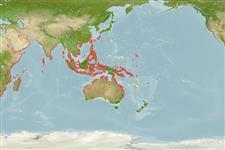Common names from other countries
>
Beloniformes (Needle fishes) >
Belonidae (Needlefishes)
Etymology: Strongylura: Greek, strongylos = round + Greek, oura = tail (Ref. 45335).
More on author: Bleeker.
Environment: milieu / climate zone / depth range / distribution range
Ecologia
marino; salmastro associati a barriera corallina; oceanodromo (Ref. 51243); distribuzione batimetrica 0 - 3 m (Ref. 86942). Tropical; 30°N - 40°S, 30°E - 180°E
Indo-West Pacific: Somalia (Ref. 30573) and Tanzania to Durban, South Africa (Ref. 3130) east to Pakistan, India, Sri Lanka and southeast Asia to New Guinea, Australia, and the Philippines. Reported from southern China (Ref. 5317). The Australian population is regarded as subspecies Strongylura leiura ferox by Parin (1967) (Ref. 1602).
Size / Peso / Age
Maturity: Lm ? range ? - ? cm
Max length : 100.0 cm TL maschio/sesso non determinato; (Ref. 3678); common length : 35.0 cm OT maschio/sesso non determinato; (Ref. 9682)
Spine dorsali (totale) : 0; Raggi dorsali molli (totale) : 17 - 21; Spine anali: 0; Raggi anali molli: 23 - 25. Laterally compressed; origin of dorsal fin over 7th-10th ray of anal fin; dorsal fin rays 17-21; anal fin rays 23-25; caudal peduncle without lateral keels; caudal fin emarginate; predorsal scales moderately small, 130-180 (Ref. 9682). Caudal fin sub truncate; a black bar on cheek between opercle and preopercle; greenish dorsally, grading to silvery white ventrally.
Inhabit coastal waters and estuaries (Ref. 5213). Larvae and early juveniles are found in mangroves (Ref. 43081). Feed mainly on small fishes (Ref. 3130) and crustaceans (Ref. 43081). Oviparous (Ref. 205). Eggs may be found attached to objects in the water by tendrils on the egg's surface (Ref. 205). Marketed fresh (Ref. 9682).
Life cycle and mating behavior
Maturities | Riproduzione | Spawnings | Egg(s) | Fecundities | Larve
Randall, J.E., G.R. Allen and R.C. Steene, 1990. Fishes of the Great Barrier Reef and Coral Sea. University of Hawaii Press, Honolulu, Hawaii. 506 p. (Ref. 2334)
IUCN Red List Status (Ref. 130435)
CITES (Ref. 128078)
Not Evaluated
Threat to humans
Harmless
Human uses
Pesca: commerciale; Pesce da pesca sportiva: si
Strumenti
Special reports
Download XML
Fonti Internet
Estimates based on models
Preferred temperature (Ref.
115969): 24.7 - 29.3, mean 28.5 (based on 2798 cells).
Phylogenetic diversity index (Ref.
82804): PD
50 = 0.5001 [Uniqueness, from 0.5 = low to 2.0 = high].
Bayesian length-weight: a=0.00148 (0.00077 - 0.00285), b=3.06 (2.90 - 3.22), in cm Total Length, based on LWR estimates for this species & Genus-body shape (Ref.
93245).
Trophic level (Ref.
69278): 3.9 ±0.64 se; based on food items.
Resilienza (Ref.
120179): Medio, tempo minimo di raddoppiamento della popolazione 1.4 - 4.4 anni (Preliminary K or Fecundity.).
Fishing Vulnerability (Ref.
59153): High vulnerability (60 of 100).
